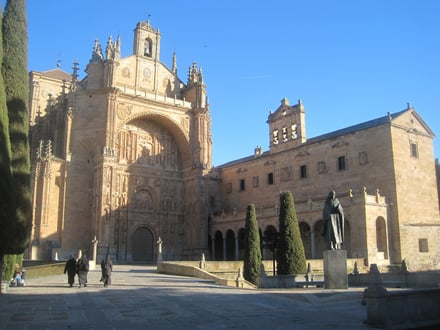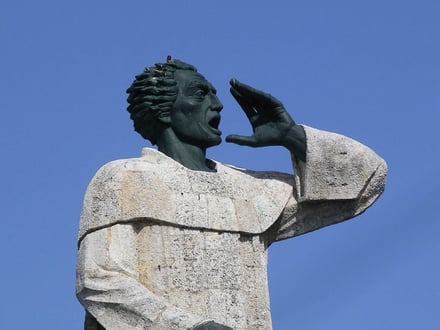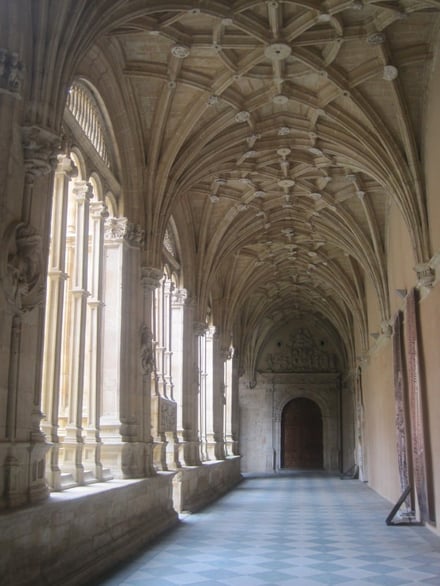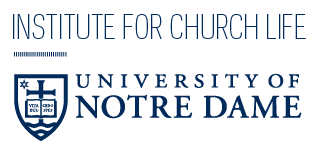The introduction of human rights language into the social mission of the Catholic Church evident in Pope John XXIII’s encyclical Pacem in terris (1963) is often seen as a delayed response to the modern world. From this perspective, Vatican II’s Declaration on Religious Freedom rode on the back of America’s centuries-old first freedom. Even the magna carta of the modern social encyclicals, Pope Leo XIII’s Rerum novarum (1891), has been characterized by some as a Catholic redaction of liberal theories of individual rights to property.
But the Catholic vision of human rights, in fact, is neither “liberal” nor “American” nor “modern” for that matter. The plausibility of this rather unconventional claim rests on whether or not it can be shown that the commitment to human rights so essential to the social doctrine of the Church today has its roots in a debate internal to the Catholic tradition, rather than developing as a delayed response to a modern political order external to it. A turn to the evangelization of the Americas in the sixteenth century provides a historical standpoint from which to observe the fact that the origins of human rights discourse in the West are firmly located within ecclesial tradition.
The Spanish Catholic mission to the New World began with arrival of Christopher Columbus in 1492. As the Admiral wrote in the first entry to his journal, the purpose of his voyage was to ascertain “the manner which should be used to bring about their conversion to our holy faith.” Ferdinand and Isabella, the Catholic monarchs of Aragon and Castile, had entrusted Columbus with a letter permitting him to travel in order to extend the faith. When the Admiral returned back to the Old World after his first voyage, the crown gave him full support and granted him oversight of island commerce, which would almost immediately begin to traffic slaves.
Before Columbus embarked on his second voyage to the New World, Pope Alexander VI blessed the Spanish mission and conferred to the crown the authority to preach the Gospel to the unbelievers across the Atlantic in the so-called letter of papal donation, Inter caetera (1493). The crown already possessed a right of royal patronage over the Spanish Church and with it the power to appoint bishops and construct churches and hospitals. As the monarchy extended its sovereignty, first through the Reconquista of Granada followed by the conquests of the Canaries and the Caribbean, it maintained royal patronage over ecclesiastical matters. Royal administration of the Church may have had the advantage of making important spiritual and moral reforms rapidly, but it necessarily placed clergy in a compromised position of being subordinate to commercial interests. Not unlike the situation of Gregory VII in the Middle Ages, the Spanish Church of the Renaissance struggled to maintain its ecclesiastical freedom.
While secular clergy were in a position of greater passivity to colonial interests, the religious orders were not. Their institutional orientation put them in a position where they could place the spiritual demands of the Gospel above economic and material concerns. In particular, their vow of poverty would provide the most important spiritual lens for not only recognizing the great injustices and abuses unfolding across the Atlantic, but also seeking solidarity with the oppressed Indians. The Spanish Dominicans were the first to speak out in this regard.
The Dominican mission to the New World began when the Master General of the Order of Preachers, Tommaso de Vio Cajetan, mandated the Spanish provincial to send his best friars across the Atlantic under the threat of eternal damnation. Three friars left the Dominican priory of San Esteban from Salamanca, Spain, and arrived on the island of Española in 1510. Their names were Pedro de Córdoba, Antón Montesino, and Bernardo de Santo Domingo.
 What these friars witnessed on the island was nothing short of appalling. Rivers of gold were degenerating into rivers of blood and disease. Following the failed governance of Christopher Columbus in the Caribbean, the condition on the islands had quickly devolved into a brutal Spanish colonial system of enslavement. The encomienda institution of forced Indian labor justified violence on the basis of the great commission to preach and educate unbelievers. Indians would be required to work and pay tribute to Spain while their local masters focused on their spiritual and physical well-being. In reality, however, the institution failed in every respect. The purportedly “free and servile” Indians, as Queen Isabella once referred to them, were literally worked to death. The Taíno natives neither had their basic needs met, nor did they receive instruction in the faith. But none of this mattered anyhow, according to the Dominican missionaries. In their view, the only justifiable reason for Spanish presence in the New World was to preach the Gospel, not to conquer and exploit the natives and their lands.
What these friars witnessed on the island was nothing short of appalling. Rivers of gold were degenerating into rivers of blood and disease. Following the failed governance of Christopher Columbus in the Caribbean, the condition on the islands had quickly devolved into a brutal Spanish colonial system of enslavement. The encomienda institution of forced Indian labor justified violence on the basis of the great commission to preach and educate unbelievers. Indians would be required to work and pay tribute to Spain while their local masters focused on their spiritual and physical well-being. In reality, however, the institution failed in every respect. The purportedly “free and servile” Indians, as Queen Isabella once referred to them, were literally worked to death. The Taíno natives neither had their basic needs met, nor did they receive instruction in the faith. But none of this mattered anyhow, according to the Dominican missionaries. In their view, the only justifiable reason for Spanish presence in the New World was to preach the Gospel, not to conquer and exploit the natives and their lands.
For over a year, as more Dominicans arrived from Spain, they patiently learned of the violence perpetrated by Christians on the island. The religious community prayed and fasted while discerning what action to take instead of standing by idly. Their strict ascetical discipline, fostered by a spiritual and intellectual renewal of the Order back in Spain, opened their hearts and eyes to see the painful reality of suffering before them.
The Advent season of 2011 marked the five-hundred year anniversary of a pivotal moment in the pastoral life of the Church with regard to the history of human rights. On the Fourth Sunday of Advent in 1511, Antón Montesino, the most gifted preacher of the Dominican missionaries, stood before a crowded church in Santo Domingo and spoke the prophetic words of John the Baptist: “I am a voice crying in the desert [Ego vox clamantis in deserto]” (Jn 1:23). He continued preaching:
I have come here to make you aware. I am the voice of Christ in the desert of this island. It would be wise of you to pay attention and to listen with your whole heart and with every fabric of your being . . . You are all in mortal sin. You live in it, you die in it. All because of the cruel tyranny you exercise against these innocent peoples. Tell me, by what right and with what justice do you so violently enslave these Indians? By what authority do you wage such hideous wars against these people who peacefully inhabit their lands, killing them by unspeakable means? How can you oppress them, giving neither food nor medicine and by working them to death, all for your insatiable thirst for gold? And what care are you providing them spiritually in teaching them about their God and creator, so they are baptized, hear Mass, and keep holy days? Are they not human beings? Do they not have rational souls? Are you not obligated to love them as you love yourselves? Do you not understand or feel this? How can you remain so profoundly asleep?
Immediately after the liturgy, there was upheaval on the island. Diego Columbus, the current governor and the son of the Admiral, threatened to notify King Ferdinand of this “new” doctrine of evangelization. A mob of angry Spaniards gathered around the Dominican house of prayer and demanded that Montesino recant. Fray Cordóba calmed the crowd and assured everyone that the decision to preach the radical message was unanimous among the missionaries.
The Spanish Dominicans fused their doctrine of rights for all persons made equally in the image of God with a profound spiritual awareness rooted in works of charity in service to truth and justice.
The following Sunday, this time before an even larger congregation, the Dominicans repeated their admonishment of slave-holders as mortal sinners. But they also raised the stakes in a way that was as scandalous as it was Christian: anyone who refused to free their laborers and make restitution would be denied absolution in Confession. According to the Order of Preachers on the island, excommunication was the last resort to effectively address such widespread injustice entrenched among members of the Church.
The fruit of the Advent 1511 sermon was nothing short of revolutionary in the religious and political history of the Latin West. The event mobilized a concerted, tireless effort to promote solidarity and a love for the humanity of so-called “infidel” neighbors, not in spite of the Gospel but in genuine service to it. Preaching the Gospel peacefully would become inseparable from defending the freedom and rights of those who received it. Achieving this aim required first the proper evangelization of Christians. The most famous of those converted by the radical message was Bartolomé de las Casas.
Las Casas had come over as a young man on the same fleet as Francisco Pizarro, who would later conquer the Inca Empire. As a secular priest, Las Casas had Indian laborers and participated in the Spanish conquest of Cuba. After witnessing the many horrors on the islands and struggling with the difficult teachings of the Dominicans, his conscience finally awakened. His conversion began during the Feast of Pentecost while reading the divinely-inspired words of Sirach 34:19–22:
The Most High approves not the gifts of the godless, nor for their many sacrifices does he forgive their sins. Like the man who slays a son in his father’s presence is he who offers sacrifice from the possessions of the poor. The bread of charity is life itself for the needy; he who withholds it is a man of blood. To take away another’s living is to commit murder; to deny a laborer wages is to shed blood.
Within a decade, Las Casas professed his vows as a Dominican and would dedicate the rest of his life to defending the natives before the Council of the Indies and the Spanish crown. He became known to friend and foe alike as the “Protector of the Indians.”
The reflexive evangelical message of the Dominicans was “new” in comparison to the preaching that characterized the Latin Christian past. The medieval Crusades and the Iberian conquests of the Canaries and North Africa had linked war and evangelization as complementary procedures of Christian expansion. Popes from the thirteenth to the fifteenth centuries such as Innocent IV, Eugenius IV, and Nicholas V had provided the theory and practice for consolidating economic, humanitarian, and religious interests into a missionary warfare policy that could subjugate pagan populations to superior Christian rulers for the purpose of converting and civilizing them.
When imperial Spain carried its mission across the Atlantic with the backing of a papal donation, its representatives claimed to offer the cure to Indian depravity in social and religious life—superior Spanish civilization. The popular Spanish chronicles of Bernal Díaz del Castillo and Gonzalo Fernández de Oviedo painted the natives as lazy or hostile barbarians naturally prone to abominable evils such as cannibalism and human sacrifice. Amerindian cultures were deemed irrational at best, sub-human at worst. Either way, they needed superior Spanish culture and its true religion because the natives were considered guilty for having committed acts contrary to the natural law that merited punishment and discipline. Evangelization by political conquest or by enslavement became the road most traveled by the civilizing project of the conquistadors and the clergy who served it.
In direct contrast to the civilizing project of the conquistadors, the project of peaceful evangelization promoted by the Dominicans recognized the preacher as the greatest obstacle to conversion, not the unbeliever. They considered a life marked by gentleness, charity, and truth as the only way to evangelize by persuasion and miracles. Christ and the Apostles provided the norm and the method. According to this teaching, the use of war, force, or terror obstructs rather than facilitates the conversion of others. The greed of the Spaniards was by far the worst form of idolatry that brought scandal to the faith.
 While this method of preaching was no different from the instruction of the Lord, the Spanish Dominicans were able to extend that original Gospel message of peaceful evangelization through the inculturation of a faith that asked “by what right” and “with what justice”. They asked those questions not on behalf of themselves, but for their persecuted Indian neighbors. The sixteenth-century Spanish Dominicans fused their doctrine of rights for all persons made equally in the image of God with a profound spiritual awareness rooted in works of charity in service to truth and justice. This unprecedented vision for the love of the unbelieving neighbor made in the image of God unsettles the over-simplified portrait of modernity’s universal aspirations breaking free from the parochial shackles of Latin Christendom. The doctrine of human rights is therefore not a product of the modern world, but a theological insight that emerged from the spiritual practices of religious orders during the crucible of Spanish conquests.
While this method of preaching was no different from the instruction of the Lord, the Spanish Dominicans were able to extend that original Gospel message of peaceful evangelization through the inculturation of a faith that asked “by what right” and “with what justice”. They asked those questions not on behalf of themselves, but for their persecuted Indian neighbors. The sixteenth-century Spanish Dominicans fused their doctrine of rights for all persons made equally in the image of God with a profound spiritual awareness rooted in works of charity in service to truth and justice. This unprecedented vision for the love of the unbelieving neighbor made in the image of God unsettles the over-simplified portrait of modernity’s universal aspirations breaking free from the parochial shackles of Latin Christendom. The doctrine of human rights is therefore not a product of the modern world, but a theological insight that emerged from the spiritual practices of religious orders during the crucible of Spanish conquests.
Sixteenth-century Spanish America was a rights culture in a robust sense even though it was not characteristically modern. The royal court and the Council of the Indies would regularly hold juntas (debates) concerning the lawfulness of certain policies, and these juntas always included the opinions of theologians and jurists. Historically, the Spanish legal tradition had produced the Siete Partidas (The Seven Divisions or The Seven-Part Code) of King Alfonso “the Wise,” which emerged out of a period of scholastic humanism in theology and canon law in the Middle Ages. During the Renaissance, Spanish scholastic-juristic thought experienced a profound renewal, especially at the famous University of Salamanca, located just steps away from the Dominican priory of San Esteban. Montesino and company brought this scholastic-juristic legacy to bear on their spiritual lives so that they could preach an orthodox message of solidarity, love, and justice for the oppressed. The eyewitness reports of the first Dominicans made it back to Spain and directly contributed to the discourse of Amerindian natural rights and political autonomy expressed through the writings and lectures of Francisco de Vitoria, Domingo de Soto, and Melchor Cano at Salamanca. These brilliant thinkers were the first to identify the image of God imprinted in every individual as the foundation for rights talk in the West.
His combination of deep theological reflection, legal acumen, and missionary experience contributed to voluminous writings and testimonies that deserve to be considered the first thorough articulation of human rights in the Americas.
The interpenetration of mission and theology, and preaching and the defense of rights, is most apparent in the scholarly and administrative life of Las Casas. His combination of deep theological reflection, legal acumen, and missionary experience contributed to voluminous writings and testimonies that deserve to be considered the first thorough articulation of human rights in the Americas. The most important theological treatise he ever wrote promoting the Christian ethic of evangelization inextricable from a doctrine of rights was De unico vocationis modo (The Only Way), dating from 1530. This treatise drew principally upon Scripture, ancient philosophy, patristic sources, canon law, and Thomas Aquinas, to condemn the doctrine of missionary warfare and affirm the natural freedom of all persons to receive or deny the Gospel as well as their political autonomy.
When Las Casas was appointed bishop of Chiapas in the 1540s, he brought a group of Dominicans from Salamanca to peacefully evangelize La Tierra de Guerra (The Land of War), a region in Guatemala notorious for inhospitable natives. It is a testament to their sincerity of faith and discipline that the land came to be known as Verapaz (True Peace), as it is still called today. Eventually, Las Casas was chased out of his bishopric by Spanish colonialists for having implemented that same uncompromising practice of ecclesiastical censure which had transformed his own life. His enemies across New Spain and Peru especially despised him for the major influence he had on the formation of the New Laws in 1542 promulgated by Emperor Carlos V. These laws temporarily abolished the encomienda institution and all wars of conquest in an effort to secure Indian rights by making impoverished natives vassals under the direct protection of the crown not subject to tributes and taxation.
The “new” evangelization promoted by the Spanish Dominicans and especially Las Casas not only influenced royal policy, if only for a short while, but it also reached the teaching office of the papacy. Following a series of juntas concerning mass Baptism, forced labor, and evangelization in Mexico in 1536, the Dominican Bernardino de Minaya went to Rome to speak directly with Pope Paul III concerning the affairs of the Indies. He brought along a parecer (document) prompted by Dominicans but also signed by Franciscans condemning religious wars of conquest and enslavement of the Indians. The document further affirmed the spiritual freedom of unbelievers to receive the faith without coercion as well as their political freedom to govern themselves independently of Spain. Las Casas, who was actually present at the Mexico juntas, exerted an unmistakable influence on this document. In addition, Minaya purportedly brought an early draft of The Only Way as he related to the Pope all the injustices that were taking place across the Atlantic.
The pastoral response of Paul III came in the form of three papal letters addressing the issues raised in Mexico that had first been raised by the Dominicans of Española. The most important of these letters, Sublimis Deus, was released in 1537. The significance of this papal bull for the history of Catholic Social Teaching is difficult to overestimate. The letter shared three core teachings with Las Casas’ The Only Way. Sublimis Deus affirmed:
- the common condition and equal nature of humanity;
- the promotion of peaceful evangelization and the condemnation of missionary war; and
- the defense of the natural freedom and rights of every human being.
Paul III began the letter with the Christian claim that all human beings were created out of love for the sake of eternal life with God. The Pope then went on to provide a most profound theological insight into the dignity of human nature:
It is necessary to confess that man is of such a condition and nature that he is able to receive the faith of Christ, and whosoever possesses human nature, is himself fit to receive the faith. Neither is it credible that anyone can be so inept as to want to obtain the end of believing and be denied the most essential means of attaining it.
It is the capacity to receive the Gospel that is the greatest mark of the dignity of human nature. Christ’s great commission to “Go teach all nations” (Mt 28:19) is therefore a simultaneous affirmation of the equality of human nature to receive the Gospel. This refers to everyone, no exceptions. And it is Christ, “Truth itself [Veritas ipse],” who provides the form and method of bringing the Gospel to all peoples.
The Pope held that the Gospel could only be genuinely presented to people if their freedom was respected in the first place. This was clearly an insight indebted to the Spanish Dominican experience in the Americas. He then warns of Satan and his satellites, who have invented a method of preaching that denies both equality and natural freedom in order to enslave and subjugate those who are outside the Church. The Pope finally concludes the letter by making a most remarkable claim about human freedom:
Those Indians and all unbelievers who will be discovered by Christians in the future, although they are outside the faith, should neither be deprived of their freedom nor their dominium over things. Indeed, they can use, control, and enjoy their liberty and dominium freely and lawfully, and should not be reduced to slavery.
Three and a half centuries before Rerum novarum and more than four hundred years before Pacem in terris, Sublimis Deus affirmed a universal doctrine of equal freedom and human rights on the basis that every person is capable of receiving the Gospel. This fact challenges the narrative impasse between progressivists and traditionalists within the Church. For progressivist-leaning Catholics, the Church’s language of human rights thoroughly proclaimed at the Second Vatican Council was a welcome reversal of tradition. For traditionalist-leaning Catholics, it was an act of betrayal. Ironically, both share the same narrative that the embracement of human rights, especially religious freedom, was a watershed in Church history.
 However, the lesson of the sixteenth-century project of peaceful evangelization demonstrates continuity rather than reversal within the tradition. The modern popes retrieved and developed a tradition of rights that extended back into the sixteenth century, and even further back into the scholastic-juristic thought of the Middle Ages. It would be a dishonor to the history of our faith, a travesty even, to forget what those Dominicans did in 1511 and how their successors such as Las Casas and Paul III carried on in the generations that followed. Their legacy is as important as ever for the Church of the New Evangelization.
However, the lesson of the sixteenth-century project of peaceful evangelization demonstrates continuity rather than reversal within the tradition. The modern popes retrieved and developed a tradition of rights that extended back into the sixteenth century, and even further back into the scholastic-juristic thought of the Middle Ages. It would be a dishonor to the history of our faith, a travesty even, to forget what those Dominicans did in 1511 and how their successors such as Las Casas and Paul III carried on in the generations that followed. Their legacy is as important as ever for the Church of the New Evangelization.
When the father of the modern social encyclicals, Pope Leo XIII, wrote his letter In Plurimis abolishing the institution of slavery in 1888, he explicitly referred to the human rights legacy of Paul III and the Spanish Dominicans. According to Leo XIII, this ecclesial tradition declared that “all had a just and natural right of a threefold character, namely, that each one of them was a master of his own person, that they could live together under their own laws, and that they could acquire and hold property for themselves” (§16). But Leo notes that Paul III did something more, which was a direct contribution of the “new” evangelization of the first Dominicans in the Americas. Paul III prohibited the sacraments to Christians as a disciplinary measure for those who refused to change their evil ways. From the perspective of Leo XIII, the ecclesial tradition of human rights affirming the liberty of all peoples over themselves, their political order, and their property was supported by the religious orders as much as the papacy in the sixteenth century.
The doctrine of human rights, as part of a long tradition of natural law, must always be in service to the Gospel.
Finally, a grave political temptation of our day is to subordinate the Gospel to a project of human rights or even natural law that can persuade the whole world of its universal message. The Spanish Dominicans and Pope Paul III teach us that the doctrine of human rights, as part of a long tradition of natural law, must always be in service to the Gospel. Furthermore, it is a doctrine directed first and foremost to believers, who must exhibit through their lives the immeasurable worth of every human being made in the image of God and redeemed by the blood of Christ. The defense of human rights or natural law should never become a mechanism for reining in or disciplining individuals and communities outside the Church who do not conform to Gospel values. Respect for human rights may be a requirement for a fuller articulation of Christ’s message in the era of the New Evangelization, but it is certainly not a replacement of the Gospel. Christians can and must demonstrate this truth by following the Lord in being ready and willing to renounce their own freedom and rights, which ultimately belong to God and not to any human authority, in order to express their love toward others, even their enemies. Only then will the Gospel become a source of salvation rather than scandal to unbelievers.
![]()
Editorial Note: This essay originally appeared in Vol. 1, No. 4 of Church Life Journal.
All images courtesy of the author.



